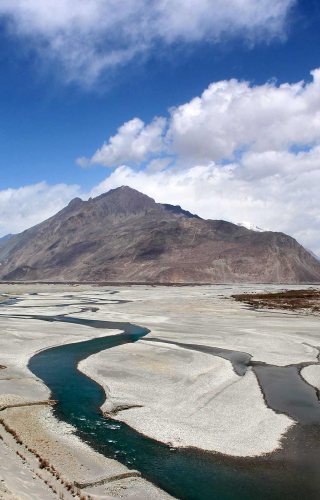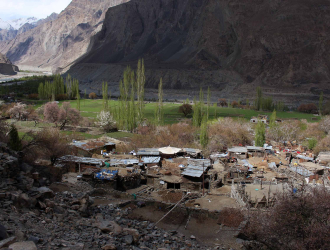The journey to Turtuk is as difficult as breathtaking. Thirty-nine kilometres from Leh, the road climbs over Khardung La, one of the highest motorable roads in India. From Khardung La, the 164 kilometres journey to Turtuk follows the course of the Shyok River, which meets the Nubra River in Nubra valley. Nubra valley is a liminal zone. The region marks the separation of not only the political geographies of India and Pakistan but also ethnicities (Balti people and Ladakhi people) and cultural influences (Buddhism and Islam). The journey through Nubra valley winds through a diverse ecosystem of barren floodplains, scree slopes, scrublands, sand dunes, deep gorges, mountain rivers, waterfalls and snow-capped ridges. The desolate landscape is broken by green patches of cultivated fields, small hamlets and precariously perched whitewashed Gompas.
The road to Turtuk then splits at Diskit, the tehsil headquarters. From Diskit, one road connects to Siachen glacier, which has been a flashpoint between India and Pakistan since the early 1980s. The Shyok River continues its journey through Turtuk, entering Pakistan beyond Tyakshi village, and merges with the Indus River at Keris, east of Skardu. Turtuk was under Pakistani occupation from 1947 till December 1971, when the Indian Army captured Turtuk during the Bangladesh Liberation War. Before 1947, Turtuk was part of the princely state of Jammu and Kashmir ruled by the Dogras, but culturally and ethnically it is an extension of Baltistan. The changing geopolitics between India and Pakistan divided the Balti people and separated Turtuk from Baltistan, which now lies predominately in Gilgit-Baltistan, in Pakistan-Occupied Kashmir. Many families have relatives living across the border and, overcoming all odds, they have retained links to Balti culture and Balti diaspora.
The highway from Diskit ends at Turtuk. The village cannot be seen from the road and lies further up the gorge face. A glacial stream divides the village into two, Yul and Farool, connected by a wooden suspension bridge built in the 1980s. Among the 320 households, many are related through intermarriage and almost everyone knows each other in the village. When I told my hosts that I was visiting Turtuk to research local crafts, I was greeted with enthusiasm and my queries invariably led to the response: ‘Ask Master Karim, he will know more.’
In 1973, Master Karim Mahapa was the first person from Turtuk to obtain an Indian Government job as a high school teacher. When we talked, Master Karim offered new perspectives about the region and its culture. He highlighted Turtuk's location at the intersection of three big cities of the region; Leh, Kargil and Skardo (in P-o-K). This made Turtuk a junction for trade and cultural exchange on the Silk Route. Ancient cave paintings, petroglyphs and Bon (animistic) graves discovered in surrounding areas allude to the region’s prehistoric past and pre-Islamic period. The Baltis are the only Tibetan ethnic group to convert to Islam, starting sometime in the sixteenth and seventeenth centuries.
I spent half a day with Mohammed Ismail Gochogopa, who described a passion for weaving. Sadly, he is one of only two practising shawl makers in the village. He has a job in Leh, and can only make shawls when he visits Turtuk on a break. He had learned weaving from his father and has taught the craft to his wife who continues weaving at home when he is away.
Next, I met Mohammed Ali Monchopa, a versatile artist who also works as a driver for the GREF (Border Roads Organisation). I found him working on his famous ibex horn walking sticks and planning to start work on a new order from an army officer for a decorative bow and arrow. His eldest son, Inayat, has now learned the craft and constantly working on innovative ideas.
Abdulla Tsarmapa is another well-known artisan, with a fine hand for wooden crafts. Back in his youth, he catered to the demands of the Indian Army. Now he makes metal stoves by recycling scrap metal from discarded kerosene barrels sourced from the army. Now in his mid-sixties, with weak eyesight, he works occasionally making cravings and repairing polo sticks. He asked me to visit the local mosque, especially to see the wood carvings. The mosque has fine woodwork, incorporating diverse geometric patterns mixed with Buddhist, Bon, and even Jewish motifs.
However, I was yet to find the person who made doltoks (stone cooking vessel), a craft Turtuk is well known for. After four days, I finally found Ghulam Mohammed Khalipa at his studio, located three kilometres outside Turtuk. His father, Abdul Karim Khalipa, repurposed stoneware to make decorative sculptural works that were inspired by local fauna, including ibex, peacocks, Bactrian camels, eagles, yaks and snow leopards. After Abdul Karim Khalipa passed away in 2016, his legacy was continued by his son Ghulam. He explained how the balsa(raw stone) was sourced from the mountains across the Shyok River, how it was laboriously hauled to his workshop, and the long tedious process of giving it form and shape. As I watched him demonstrate the carving process, he told me how doltoks were highly prized and traded in the past, but is hardly used anymore, except for roasting barley and making pabha, a kind of local bread. Turtuk’s old-timers agree that food cooked in a doltok tasted better, and most households will have one old doltok in the kitchen. With cheaper alternatives available in Leh’s markets, the challenge for Ghulam Mohammed Khalipa is cutting down the high cost and increasing output. A medium-sized doltok takes approximately ten days to make and is priced at 4-5 times the cost of a pressure cooker.
For six months a year Turtuk is effectively cut off from Ladakh due to heavy snowfall. If anything, the remoteness has made the villagers self-reliant in solving their day-to-day needs. But isolation ended in 2010 when access to Turtuk was opened to boost tourism in the region. While it undoubtedly brought economic benefits, tourism is seen as a double-edged sword by the conservative community, and many harbour reservations on the effect tourism will have on the values and aspirations of the next generation.
The preservation of Balti cultural fabric is a cause of utmost importance for Turtuk’s villagers. There is strong self-awareness to protect Balti culture, language and heritage by effectively tapping the tourism potential. Some have invested tourism revenue in conservation. The two museums in Turtuk, one at the Royal Palace run by Kacho Khan, a descendant of the Yabgo kings of the past, and the other, The Balti Heritage House, a traditional house of the Ashurpa family, are both great examples of maintaining heritage as a living space, which when necessary, accommodates tourists as visitors. Both these museums offer guided tours by the owners, who happily showcase their inheritances and delve into stories of their land and ancestors.
A number of hotels, guesthouses and restaurants have also opened, and WIFI has reached Turtuk. Hussain Beg, a member of the local panchayat and a new hotel owner, spoke of his aspirations of making his village organic and banning all forms of chemical fertilisers. Turtuk and the surrounding areas have led campaigns against the harms of tobacco, and have successfully banned cigarettes. In this regard, many local craftsmen are also innovating to cater to the new demands of an emerging tourist market, both locally and in Leh. However, one serious question arises here: How long will the value and efforts of Turtuk’s inhabitants hold in the face of increasing migration, the emergence of new markets, the impact of unrestricted tourism, climate change and the hazards of living close to a conflict zone?














